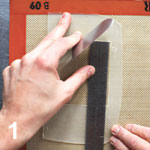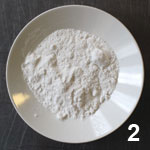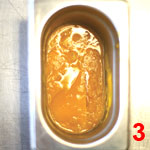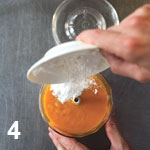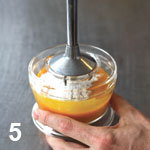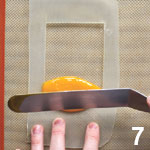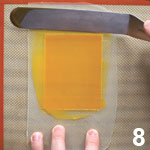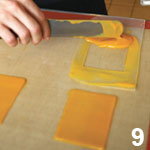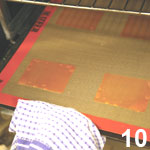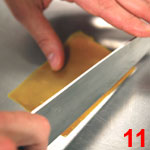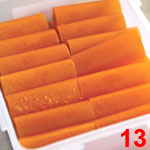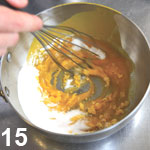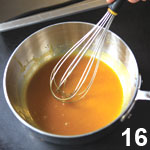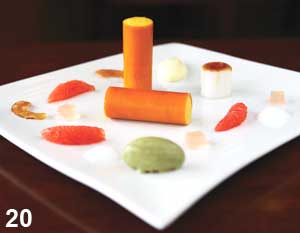Masterclass with Martin Burge: Mango Cannelloni
Mango cannelloni are the focus of a Whatley Manor dessert that fills the plate with a balanced combination of colours, textures and tastes. Michael Raffael explains how to cook Martin Burge's creation.
A decade ago chefs were making tuiles from fruit purées. Twenty years ago and more they were preparing crisps out of wafer-thin apple slices to stick in sorbets. These methods have slipped into the standard pâtisserie repertoire. Going back more than a century, fruit leathers were wads of dried fruit purée on which children chewed as a treat.
Martin Burge's mango cannelloni crisps draw on such influences. To make them, though, requires know-how, technical skill and a measure of dexterity. The recipe is practical, but has taken him more than a little R&D. In its current version, he is low-temperature baking the purée for 16 hours. Before, he was experimenting with 30 minutes at 130°C. The difference, he says, is both in the colour and the taste of the fruit. It doesn't taste boiled or caramelised.
At Whatley Manor in Wiltshire, the cannelloni filled with a mousse are one element of a composite dessert. This suits the ethos of luxury dining. In a different restaurant setting they would stand on their own. Change the fruit from mango to apple or damson, rename the dish a "brandy snap" and the recipe would slot into any modern British pub's pudding menu.
MARTIN BURGE
At the two-Michelin-starred Whatley Manor in Wiltshire, Martin Burge approaches cooking from a pragmatic point of view. He senses that some of his peers can be carried away by an over-imaginative concept. "They forget," he suggests "that food is there to be eaten."
Nobody could accuse him of lacking the creative spark, but he tempers it to devise dishes that are accessible. Yes, he is influenced by what the Spanish New Wave is doing. Yes he's happy to learn from their tricks.
At 37, he hasn't forgotten his formative years in the 1990s when he learnt his craft in the kitchens of Richard Neat at Pied à Terre, at Raymond Blanc's Manoir and with John Burton Race at L'Ortolan.
These, predominantly French inspired mentors, have given him a delicacy and a lightness of touch. His cooking, while contemporary, is bound seamlessly to his roots.
Photos by Lisa Barber (www.lisabarber.co.uk)
MANGO CANNELLONI WITH MINT ICE-CREAM, LIME CURD AND PINK GRAPEFRUIT
INGREDIENTS
(Serves four)
- 8 filled mango cannelloni
- 4 x 12g quenelle mint ice-cream
- 4 x 15-20g quenelle lime curd
- 4 x 20g caramelised coconut gel
- 4 x 3 cubes grapefruit jelly
- 4 x 3 pink grapefruit segments
Optional garnishes
- Toasted coconut chips
- Mache leaves
- Coconut milk foam
ESSENTIAL EQUIPMENT
Apart from regular kitchen equipment you'll need a cannelloni stencil, a tube for shaping them and silicon crystals to keep the cannelloni brittle during storage.
ADVANCE PREPARATION
Stencil Use some kind of plastic sheeting about the thickness of a Tupperware container lid, roughly 1mm thick. Cut out a rectangular 10cm x 8cm stencil with generous edges, at least 5cm along the short sides and a little less down the long ones (1).
Cylindrical tube Make a cylindrical metal tube (eg, copper pipe) 3cm diameter and about 30cm long with a smooth surface to shape the cannelloni around.
SPECIAL INGREDIENTS
- Anti-humidity icing sugar from Sosa (www.sosa.cat) (2).
- Neutral acid, to provide a hint of acidity without changing flavour, for instance, cream of tartar.
- Mango purée or pulp (3).Burge buys a branded variety, Boiron, rather than fresh mango, because he needs consistency of taste, texture and moisture content.
- Silicon crystals. During storage, the cannelloni are stored in sealed containers on a bed of silicon crystals.
PLANNING
The Whatley Manor pâtisserie makes 2-3 batches of 20 cannelloni crisps and mousse - 10 portions each - per week.
Preparation is over 2-3 days. Prepare the mango cannelloni purée and arrange the raw mixture on Silpat mats. Leave it to settle overnight or for one day in the coldroom. Drying out takes 16 hours at 85°C in a convection oven. After baking, the cannelloni can be shaped and then stored.
The mousse should rest overnight after it's freshly made, but will keep under chill conditions for at least four days.
MANGO CANNELLONI CRISPS
INGREDIENTS
(Makes 10 pieces, five portions. This recipe is half the usual batch size, but can be scaled up as required)
- 22g anti-humidity icing sugar
- 500mg neutral acid
- 200g mango purée
METHOD
Sift the sugar and acid. Combine with the purée (4) and blend thoroughly with a hand blender (5) to obtain a smooth, homogenous mixture (6). Turn into a container.
Put a Silpat mat on a heavy-duty baking sheet. Lay the stencil on it. Spoon a liberal quantity in this template (7) and spread it evenly with a palette knife (8). Lift the stencil and scrape any excess back into the container - there should be a fair bit. Repeat the process with the rest of the mixture. You will be able to fit six cannelloni per mat (9).
Leave the raw cannelloni to set overnight, or up to one day. Dry them out in a preheated oven, 16 hours at 85°C (10). Trim the edges while they are still hot in order to obtain a perfect finish (11). Keep hot.
To form the cylinders, you need a hot-to-the-touch work surface, typically the front of the range or the hotplate area.
At this stage the mango cannelloni are plastic. To shape each one, roll it around the cylindrical tube and seal the edge (12). The long side of the rectangle goes round the tube so the cannelloni are about 8cm high when ready. Slip it off the tube and repeat the process.
To store, prepare a shallow bed of silicon crystals in a container (13). Cover with a sheet of parchment. Pack the cannelloni on top and cover with a tight-fitting lid.
MANGO MOUSSE
INGREDIENTS (To fill 10 cannelloni. Half a batch size. Doubled, it will fill a disposable piping bag)
- 4g leaf gelatine
- 200g mango purée
- 20ml lime juice
- 60g caster sugar
- 100ml whipping cream
METHOD
Soak the gelatine in water until soft (14).
Combine the mango purée, lime juice and sugar (15).
Put half the mixture in a small pan. Squeeze the moisture from the gelatine and add it to the purée in the pan. Warm just enough to dissolve the gelatine and take it off the heat (16).
Combine with the rest of the purée in a bowl. Whisk the cream to form soft peaks.
Over ice, stir the bowl of purée until it starts to go oily - a sign that the gelatine is starting to set - and fold in the whipped cream (17).
Transfer the mousse to a disposable piping bag and refrigerate overnight (18).
FILLING THE CANNELLONI
This should be done to order when plating the final dish.
Snip the end of the piping bag so the hole is a little narrower than the cannelloni's hollow tube. Fill the cavity with mousse (19) and scrape the ends flat with a small palette knife to obtain a neat finish.
VARIATIONS
Burge has adapted this recipe to raspberry and blackcurrant cannelloni. It could be varied, either by changing the fruit or by adapting the concept. For instance, the unrolled cannelloni could be made into lasagne crisps. There's also scope for combining, say, apple cannelloni filled with blackberry mousse.
MINT ICE-CREAM
INGREDIENTS (Makes about one litre)
- 100g fresh mint
- 300ml milk
- 7 egg yolks
- 175g caster sugar
- 300ml whipping cream
- 5 drops mint essential oil
METHOD
Put the mint and milk in a pan. Simmer to infuse. Whisk the yolks and sugar till they whiten. Whisk the milk minus the mint into the egg and sugar mixture. Reheat in a clean pan until the custard coats the back of a wooden spoon. Sieve it into a bowl and stir in the cream and mint essence. Churn in an ice-cream machine.
LIME CURD
INGREDIENTS
(Makes about half-a-litre)
- 125ml lime juice
- 125g caster sugar
- 50g unsalted butter
- Grated zest of 2 limes
- 150g whole egg
METHOD
Heat the lime juice, sugar, butter and zests to simmering point. In a bowl, whisk the eggs till smooth. Whisk the liquid into the eggs and continue beating until smooth. Put the mixture in a bain-marie and, stirring often, heat until curd thickens to a hollandaise-like texture. Strain through a sieve and chill. Freeze in a Pacojet container and Pacojet individual portions to order.
CARAMELISED COCONUT GEL
INGREDIENTS (Makes about 400g)
- 20g desiccated coconut
- 100ml water
- 90ml coconut milk
- 75g coconut purée
- 1dsp caster sugar
- 500mg salt
- 8ml Malibu rum
- 10g veggie gel
- Granulated sugar for caramelisation
METHOD
Toast the coconut under the grill until it starts to colour. Add it to a small pan of simmering water and leave to infuse. Strain into a fresh pan containing the other ingredients, bar the sugar, for caramelisation. Simmer for four minutes. Turn into a small film-lined container. Set and turn out. Use a cutter to cut cylinders. Sprinkle sugar over each one and glaze with a blowtorch.
GRAPEFRUIT JELLY
INGREDIENTS (Makes 225ml)
- 550mg gelatine
- 115ml pink grapefruit juice
115ml stock syrup [50:50 sugar and water]
METHOD
Soak the gelatine in water until soft. Combine juice and syrup. Put half the liquid in a pan. Squeeze moisture out of the gelatine and add to the liquid in a pan. Warm until the gelatine dissolves. Combine with the rest of the liquid. Stir and set in a shallow container. For the mango cannelloni dish, cut into 2cm cubes.
PRESENTATION
Stand one cannelloni upright in the centre of the plate and a second on its side next to it (20).Arrange the quenelle of lime curd at the back of the plate and the mint ice-cream at the front. Stand the caramelized coconut gel next to the cannelloni. Decorate the plate with the rest of the ingredients.
Photos by Lisa Barber (www.lisabarber.co.uk)



